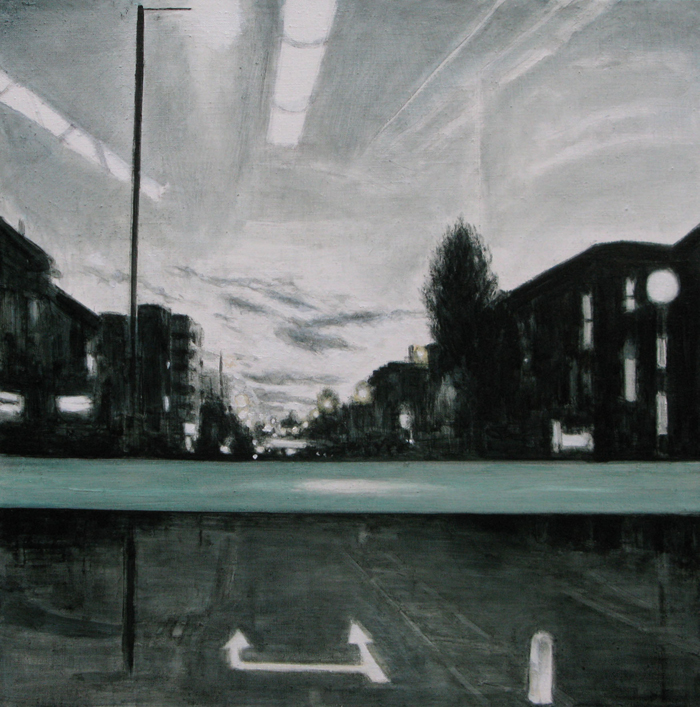Marguerite Horner’s paintings invite viewers, but push them away simultaneously. She presents us with snapshots of the seemingly mundane: an unexceptional window at the top of a residential building, a sliver of dual carriageway in profile, a petrol station, a rundown shop in a tired suburban street, or a solitary woodland walker. The very banality of these scenes suggests that they have nothing to hide. Yet, in almost every instance, what would ordinarily be the focal point of a painting is either obscured or omitted altogether. In many cases, the obscurant takes over as the focus. We are not looking at a view, but what adheres our ability to discover that view.
I’m reminded of Edgar Degas’s 1879 painting Jockeys Before the Race. As the title suggests, Degas captures the moment before the action. The void filled inertia welcomes a distraction before the race fills the void. Here, the potential energy is contained and thwarted by the visual barrier that interrupts the calm before the storm. The viewer’s agency is obscured by this visual impediment. The moment before the start of the race is spliced. Does the starting point provide relief, or does it describe the agony of the void?
In Holding on to the Things I Believe (2013), it seems like Ms. Horner is sitting on a train, or perhaps the upper deck of a bus at dusk. She reveals to us an ordinary urban street, window reflection of quotidian shops partially hidden by the light inside the bus. The line of the window across the lower portion of the painting functions as a great girder that holds the painting together. Holding and hiding. What is out is veiled by what is in. Clarity is lost in reflection. This is a view from the inside; a quiet, brooding, unsettled view. It does not claim objectivity for itself. It is honest.
Ms. Horner paints in monochrome. Occasionally, a fragment of color creeps in like a slash of muted cherry red on a car or a hint of pale blue in a cloud. However, that too, severs our reconciliation of the scene. It serves to augment the overall colorlessness, not to contradict it. The imposing, almost overwhelming chiaroscuro of her early paintings has softened lately, but a sense of the uncanny remains. There is a strong feeling that the narrative is being played out elsewhere, that we are missing something and perhaps willfully so. It is unsettling. Constantly, one feels the urge to look over the shoulder. A threat looms. It is a closed narrative, a Hitchcockian tale.
In Forward (2013), the dualistic and conflicted nature of this monochromatic world is evident with the slash of color that subverts the banal scene. A clear indication of intent is given in the title, and the markings on the road concur. The reflections in the sky provoke us, but two powerful lines intersect in the lower left-hand portion of the painting arrests our movement completely. Here we are, propelled forward and invited in without doubt, but aggressively blocked and pushed away. There is nowhere for us to go. We become outsiders, cut off from the world, isolated and alone. We are afforded small glimpses of a world so grotesquely monotonous, but given nothing more than that.
By. Beverley Knowles
























